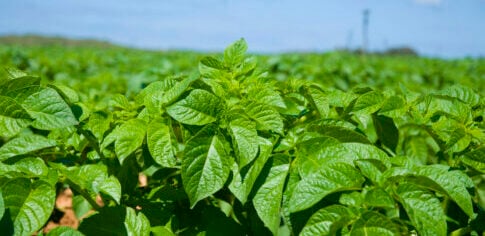Growing Potato
crop nutrition advice
Everything you need to know about fertilising potatoes, best practice, suitable products, field trials and more.
Crop nutrition advice for growing potato (Solanum tuberosum)
-
Potatoes perform best in soil with a pH between 5.5 and 6.7.
-
Potatoes thrive well and give the best yield in sandy loam to slit loam, organically rich and well-drained soil typical of those found in the Gangetic Plains of Uttar Pradesh and West Bengal.
-
In soils with a high pH (above 7.5), phosphorus mainly, but also other micronutrient deficiencies may appear.
-
In high pH conditions, potatoes are susceptible to scab bacterial infection caused by Streptomyces scabies.
-
The optimum conditions for root development and tuber initiation are well-drained, aerated soils, with temperatures between 15 and 20°C.
-
Shorter days will help tuber initiation whereas longer days will delay it.

Potato plants with healthy leaves

Potatoes harvested in optimum condition
Nutrient requirements
Estimated nutrient uptake (kg/t) by:
| N | P2O5 | K2O | MgO | SO3 | CaO | |
|---|---|---|---|---|---|---|
| kg/ha | kg/ha | kg/ha | kg/ha | kg/ha | kg/ha | |
| Tubers | 3 | 1.5 | 6.5 | 0.4 | 0.7 | 0.5 |
| Above-ground biomass | 1.9 | 0.6 | 5.3 | 0.2 | 0.4 | 0.25 |
Source: IPNI
Role of nutrients
| Key parameter | N | P2O5 | K2O | MgO | CaO | SO3 |
|---|---|---|---|---|---|---|
| Yield | ++ | + | ++ | + | +/- | +/- |
| Tuber size | ++ | ++ | + | |||
| Tuber weight | ++ | + | ++ | |||
| Skin set | - | + | + | |||
| Bruising and handling | - | + | ++ | ++ | ||
| Tuber colour (internal blackening) | +/- | + | ||||
| Dry matter content | - | +/- | - | +/- | ||
| Starch content | - | + | +/- |
+ = improving
– = decreasing
+/- = different results, depending on the rate of nutrient applied
Source: IPI bulletin – Fertilizing for high yield | POTATO
Nutrient deficiencies
| Nutrient | Description | |
|---|---|---|
| Nitrogen | Leaves are pale green (general chlorosis). Old leaves remain yellow, while younger leaves turn darker. Plants will produce fewer stems and tubers. |
|
| Phosphorous | Plant growth is stunted. Darker colour than normal. The lower leaf surface is a grey-green colour. Leaflets roll upwards if deficiency is severe. It occurs on calcareous and heavy soils, where P can be fixed. |
|
| Potassium | Potassium deficiency symptoms normally include a scorched appearance with black pigmentation and necrotic edges (dead tissues). Symptoms appear on the young, full-sized leaves. Common in light soils due to easier leaching. |
|
| Calcium | Moderate calcium deficiency may not appear but in severe situations, the leaf margins can be affected. Brown blotches may appear around the stolon end of the tubers. Tubers may show severe skin cracking. Deficiencies are severe in soils with a pH below 5. |
|
| Magnesium | Chlorosis of leaf margins of older leaves. Yellowing Symptoms appear first on the older leaves, due to magnesium's mobility. General chlorosis with veins remaining green. Scorched appearance caused by interveinal necrosis. Can occur on sandy soils and if high K levels are applied. |
|
| Sulphur | Symptoms are similar to nitrogen deficiency, but deficiency symptoms occur first in younger leaves (as yellowing). General chlorosis. The yellowing is uniform and general. It may occur on loamy, sandy soils. |
Guides & Articles
Q&A
Here are some frequently asked questions we received from farmers regarding growing potatoes.
You will need to apply 300 kg/ha of potassium per ha to meet your yield targets.
Sulphur is essential for all crops. In potatoes it can reduce storage sugars and help with production issues.
Calcium is important for the development of roots and shoots and also helps reduce storage losses.
Yes, improving the health of the soil will improve water management and nutrient availability.
When maximum and minimum temperatures are about 30–32°C and 18–20°C respectively.


